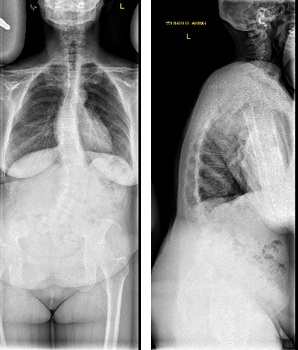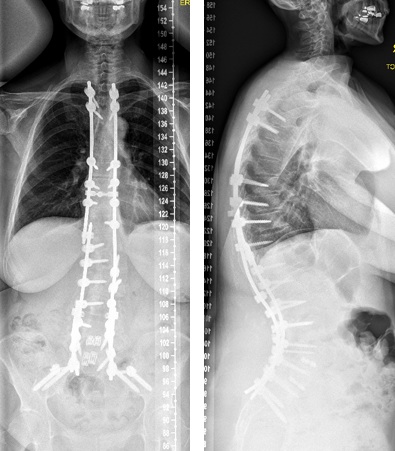- Home
- Patient Area
- Adult Degenerative Scoliosis
What is adult degenerative scoliosis?
This is the name given to a scoliosis which causes problems in adulthood. There are 2 types of adult scoliosis:
- A childhood scoliosis that develops symptoms in adulthood due to degenerative change (wear and tear)
- A scoliosis that first appears in adulthood and is usually a result of worn out joints and discs (sometimes called de novo scoliosis)
Adult degenerative scoliosis may be called Adult Spine Deformity (ASD).
A scoliosis means that the spine is curved abnormally when viewed from the front or the back. In adults it may show itself as a shape change with asymmetry of the trunk. Sometimes it results in a feeling that you cannot stand up straight anymore (loss of sagittal balance). The commonest problem in adult scoliosis is pain either in the back or the legs.
How would I know I had scoliosis?
Either you or someone else may notice that you are not standing straight or that you have changes in the shape of your spine. Alternatively you may have pain in your back and or legs and it is only after you have tests that an adult scoliosis is identified.
You may notice:
- Rib cage sticking out on one side especially at the back
- Your hip or waist sticking out
- Not being able to stand up straight easily
- You may have pain in the back
- You may have pain in the legs or pins and needles due to nerve root pressure
Why does it matter?
The main problem with adult scoliosis is pain in the back or legs. The pain can be due to the worn joints and discs in your back. The same worn joints or discs can cause pressure on nerve roots resulting in pain into the legs, pins and needles or difficulty walking.
If your symptoms are mild, nothing may need to be done. If your symptoms are more severe, treatment could be considered.
Sometimes, the inability to stand up straight or other shape changes can become troublesome and need assessment or treatment.
What should I do if I think I have adult scoliosis?
Speak to your GP. Your GP will be able to examine you to see if there is a problem. If your GP is concerned, they will refer you to a Spine Surgeon at a recognised spine centre for further tests.
If you can, keep going with activities. If the pain is worsened by activities then reduce those activities that bother you most. Consider taking painkillers provided by your GP.
If you develop numbness or weakness then notify your GP as soon as possible.
How will the doctors check if I have adult scoliosis?
The first thing the GP or specialist will do is talk to you about your concerns. They will ask you questions about your health generally and how the problems are affecting you.
The doctors will want to examine you. They will need to examine your back, your ams and your legs, so you will need to get undressed for this. Often the hospital will give you a gown, but wearing shorts and a T shirt or sports bra may make you feel more comfortable. Your back and your legs will be examined to make sure the spinal cord and nerve roots are working normally.
The Spine Surgeon will send you for X - rays. These are necessary to see if there is a scoliosis and how bad it is. Further tests such as an MRI scan are usually needed.
How can you treat adult scoliosis?
Pain killers
The commonest initial treatment is pain killers. Often the GP will start these. They may be for the back pain and or the nerve root pain. Examples of pain killers used are paracetamol, codeine, amitriptylline or gabapentin. If this is enough to help your symptoms, it may be that no further treatment is required.
Physiotherapy
Although physiotherapy doesn't cure the scoliosis or the degeneration, it can help the pain. It is therefore worth trying. Physiotherapists may try acupuncture and other methods as well as exercises.
Bracing
Braces are rarely used in adult scoliosis. Your specialist will explain the brace and its uses if it seems an appropriate treatment for you after assessment.
Injections
Injections are a common way of treating adult scoliosis. They may help control the pain enough to keep you functional. They can be into the joints in your back or around the nerve roots. The injections use a combination of steroids and local anaesthetic. They can be repeated if necessary. The main down side for injections is that they don't work for everyone and if they do work they can wear off. The upside of injections is that they are low risk and relatively easy to have done.
Surgery
Surgery in adult scoliosis is a fairly major undertaking. It is often quite major surgery. As most people have other medical conditions as they grow older, operations can be even more challenging. Most spine centres that do this sort of surgery will ensure that you have gone through all the non surgical methods first before considering an operation. There will be a need to assess your fitness for surgery. Sometimes an intensive care or high dependency bed will be required after the operation to monitor you closely after surgery.
The exact operation will be decided with your specialist. The risks and advantages as well as the post operative care will depend on the type of surgery required.
A decompression is a relatively small and straightforward operation to relieve pressure on nerve roots. It is not always possible to be used in isolation in adult scoliosis, but when it is it usually has good success rates for relieving leg pain in particular.
A posterolateral fusion with a decompression is an operation that relieves pressure on nerve roots as well as fuses part of the spine through a cut on your back. It involves rods and screws being placed in your spine.
A posterior instrumented scoliosis correction is a more major procedure that involves realigning your spine to straighten it. It may involve a decompression at the same time. It may involve inter body cages (implants) to fuse the disc spaces. It may involve osteotomies (bony cuts) to change the shape of the spine bones to help realign them.
An anterior and posterior instrumented scoliosis correction involves an operation on the front or side of the spine (through a cut on your tummy) first and then an operation on the back of the spine with rods and screws. It is a big operation to realign your spine.


Example of before and after Surgery
.png)